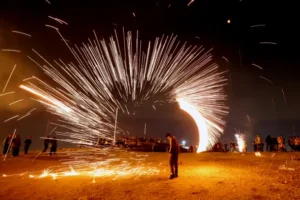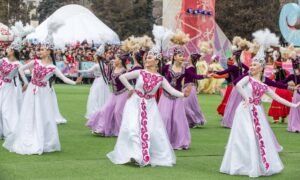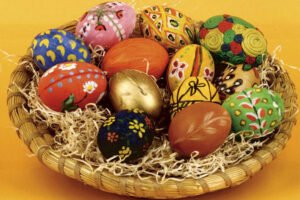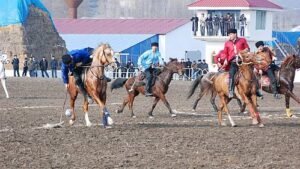Nuzhat Rana
The spirit of Nowruz is transnational and this is exactly why over the years, its celebrations have reached the far corners of the world. Nowruz is the celebration of the dawn of spring which coincides with the New Year of the Persian Calendar. Decades ago, it could be a religious observance but festivities of Nowruz today are mostly a message of generosity, renewal, new starts, fresh hopes, and manifesting the best for the coming year.
Nowruz is celebrated when spring equinox occurs. The equinox is that time of the year when the Earth aligns itself in a way that both hemispheres get equal sunlight. This is why people around the world feel enthusiastic about these celebrations, for who doesn’t like spring. Nowruz and its festivals are most-commonly celebrated in Middle East, Central Asia, including Azerbaijan and Afghanistan, and some parts of Turkey, including the Kurdistan region.
Persian speaking communities remain the torch-bearers of Nowruz for over 3000 years. These communities have been able to establish Nowruz as an International Day that represents nothing but peace, happiness, rejoicing in nature, and celebrating food and family.
Wishing a joyous #Nowruz to all those celebrating this festival in Pakistan and around the world!
As millions of people come together to enjoy Nowruz festivities, they cherish their loved ones, reflect on the blessings they enjoy, and welcome new beginnings with hope and…— Shehbaz Sharif (@CMShehbaz) March 20, 2025
March 20th is the The International Day of Nowruz. However, Parsi and Persian communities celebrate it according to their calendar. Esfand is the last month of the Persian calendar which usually has 29 days, except for the leap year. The celebrations of Nowruz erupt around the 28th day of Esfand and last for around two weeks.
Haft-Seen is the biggest highlight of the Nowruz season, so much so that it has become symbolic to Nowruz celebrations worldwide. Haft-Seen is the Nowruz feast table but not any ordinary, random food display. People who celebrate Nowruz believe that the food on the table must be picked meaningfully and that it represents the goodness we want in our lives.
Let’s have a look at how Nowruz is celebrated in different countries.
Iran
In Iran, the Fire Festival, locally called Chaharshanbeh Soori, on the last Wednesday of the Persian Calendar is the core of the Nowruz celebrations. The roots of this fire play are in the Zoroastrian celebration of lighting a fire and dancing around the flame.
Over time, various adaptations of the festival have come about in Iran. Families light bonfires and chant slogans around them. One of the slogans goes like: My yellowness is yours, and your redness is mine. People also light lanterns and shoot them in the air.
Apart from the Fire Festival, Nowruz festivities continue for 13-15 days in Iran. Street markets are decorated, family and friends exchange gifts, musical performances fill the air, and Haft-Seen tables are set for big feasts.

Usually, alongside some traditional dishes, Haft-Seen tables are decorated with fresh produce of fruit.
One of the 13 days is called Sizdah Bedar, where people spend a day outdoors in nature. This is believed to bring good luck for the year ahead and culminate a strong connection with the world of nature.
This year, Iran’s administration has laid out a Maritime Travel Facilitation Plan to smooth out the travel experience of locals and tourists in this holiday season.
Iran’s Ambassador to Pakistan wished Nowruz to people of Iran and Pakistan, in a post on X. He highlighted the sentiment of the celebrations and specifically mentioned Haft-Seen.
March 20th; recognized by UNGAR as the International Day of #Nowruz or #نوروز:
New Year celebrated in the ancient Persian civilization basin in various countries for over 3,000 years. Based on the #Persian Solar Hijri calendar, on the spring equinox, it marks the beginning of… pic.twitter.com/ATpPdcWkKN— Reza Amiri Moghadam (@IranAmbPak) March 19, 2025
Egypt
Nowruz remains one of the most enduring festivals, whose celebrations date back to as early as 5000 years. Famous Persian poem, Shahnameh, captures the most famous legends around the birth of these celebrations. As time passed, Nowruz became synonymous with spring and rebirth – now commonly known as a festival of renewal and hope.
In Egypt, Nowruz is called Nairuz Qubti and festivals include fire show and splashing water over one another.
Haft-Seen spread here includes wheat sprouts, flowers, apples, and garlic; each with its own symbolic significance.
In cultural psyche around Nairuz Qubti, apple is for beauty, garlic for health, and wheat sprouts for growth. Flowers are added to reflect spring and add the beauty of the table.

Kazakhstan
Central Asia is home to Nowruz festivities. Most of the celebrations and rituals are rooted in the traditional nomadic culture. The Central Asian variant of Nowruz is called Nauryz.
In Kazakhstan, Nowruz is celebrated for three days. This year, Nauryz is officially on 22nd March in the country. Some early celebrations started on 14 March in the Mangistau region. Children, old men and women, and people of all ages actively took part in the show. Rehearsed performances on stage entertained the audience.
Nowruz in Kazakhstan is all about its Iranian and Turkic ethnicities. During the 3-day festivities, folk festivals, sports, concerts, exhibitions, and musicals events are lined up to maximize the joy of these holidays.
Cultural dances performed by young women clad in traditional, colorful clothes are a high spot in Kazakhstan’s Nauryz.

As for the signature food on Nowruz in Kazkhstan, Nauryz kozhe is the festive dish which symbolizes prosperity and abundance in the new year. This dish has seven main ingredients; milk, meat, butter, millet, rice, and corn.
Uzbekistan
The Uzbek people get together with family and neighbors over the preparation of the Nowruz delicacy, Sumalak. It is made with sprouted wheat seeds and is full of healthy nutrients. The seeds are mixed with flour and butter and the final product is a pudding that the Uzbeks cherish only once in a year.
Sumalak is one of the seven traditional dishes that are associated with Nowruz in Uzbekistan. Another savory delight is khalim which is made with a variety of meet and grain seeds.
After meeting family, friends and neighbors over the food table, the Uzbeks play a sport called bouzkachi on the Nowruz Day. This game, in which horsemen compete for a headless carcass, has survived over centuries and is particularly famous among Central Asian tribes.
Tajikistan
In Tajikistan, Nowruz celebrations last for five to six days. Prior to the mainstream Nowruz festivities and the official holidays, the farmers in the peripheries of the country gather to celebrate juftbararan or sari juft on 7 March. This is a yearly custom of cleaning the ditches and preparing them to store clean water. In this ritual, the elderly farmers collect some wheat grains in their coats’ pockets and say a prayer.
It is believed that this ritual enhances crop produce for the new year. In the Pamir regions of Tajikistan, where agricultural activity is limited, the Nowruz rituals are linked with home animals. The essence of all these customs is to manifest more produce and fuller food baskets for the families of the community.
Like Iran, Tajiks also observe a day in nature amidst Nowruz. In the urban parts of the country, mask festivals are very common. All those taking part in the circus put on face masks and march through the streets, singing and dancing.

Decorating eggs with golden embellishments is also a regular feature of Nowruz in Tajikistan.
Turkmenistan
In Turkmenistan, Nowruz is a public holiday and is celebrated with vibrant events. On this holiday, people visit each other’s homes and exchange gifts. The hosts serve their guests with luxury delicacies which are specific to Nowruz.
A very popular Turkmen dish associated with Nowruz is dushbara, a type of dumpling filled with minced meat and served in a savory broth. Additionally, Kebabs are also widely enjoyed, as Turkmen cuisine is mostly meat-based.
The government of Turkmenistan sponsors large-scale festivals that include traditional music performances, dancing, and displays of Turkmen culture.
Another key feature of Turkmen Nowruz is the Chovkan game, a traditional equestrian sport that is deeply rooted in Turkmen history and culture. The game is played with two teams of horsemen, who attempt to carry a leather ball to the opposing team’s goal.
This is definitely different from Uzbek bouzkachi but the two are often confused because both games are played by men on horses.

Kyrgyzstan
In Kyrgyzstan, Nowruz brings communities together to celebrate nature, family, and unity. The Kyrgyz people have a rich nomadic tradition, and it is extensively reflected in their Nowruz celebrations. Just like Tajikistan, the customs here are rooted in agricultural and animal husbandry practices.
The festival spans several days, beginning with chakan, a ritual to clean and purify homes and neighborhoods. It is believed that this ritual will bring blessings for a fruitful year ahead.
Traditional Kyrgyz food, such as beshbarmak – a dish made with boiled meat and noodles, kurt – dried yogurt balls, and pilaf – rice cooked with meat, vegetables, and spices, is served during the Nowruz celebrations.
Horseback riding is also an essential part of the festivities, as it reflects Kyrgyzstan’s nomadic heritage. Additionally, in many parts of Kyrgyzstan, people play Ulak Tartysh, which is basically Kyrgyz variant of bouzkachi. Horsemen compete to get a goat carcass and carry it to the victory line.
Azerbaijan
In Azerbaijan, Nowruz is a joyous celebration that revolves around a mix of ancient traditions, folk customs, and modern festivities. The holiday is celebrated with much fanfare, beginning with a pre-festival ritual called “Kosa-Kosa,” where people dress in colorful traditional clothing, sing folk songs, and dance in the streets.
The preparations for Nowruz also include cooking a variety of special dishes, one of the most notable being plov, a rice dish made with saffron, dried fruits, and lamb. Plov is very close to the Kabuli Pulao savored in Afghanistan and Pakistan.
In Azerbaijan, Haft-Seen tables are decorated with symbolic items, such as sumakh – a spice that symbolizes the sun, hazelnuts which represent fertility and pomegranate – signifying health and abundance.
Novruz Bayramınız Mübarək!
Qoy bu əziz bayram hər evə, hər ocağa bol sevinc, ruzi-bərəkət və firavanlıq gətirsin.
Happy #Novruz Holiday!
May this joyful holiday bring a lot of joy, abundance and prosperity to every home and every hearth! pic.twitter.com/wLzby9Eshg
— Azerbaijan Emb. to Pakistan (@AzEmbPak) March 19, 2025
One of the signature events of Nowruz in Azerbaijan is the “Novruz bayram” festival, which involves outdoor games like gaval dash, a traditional game where players try to knock over a wooden target with a ball.
Nuzhat Rana is the Managing Editor (website) at The Diplomatic Insight.




